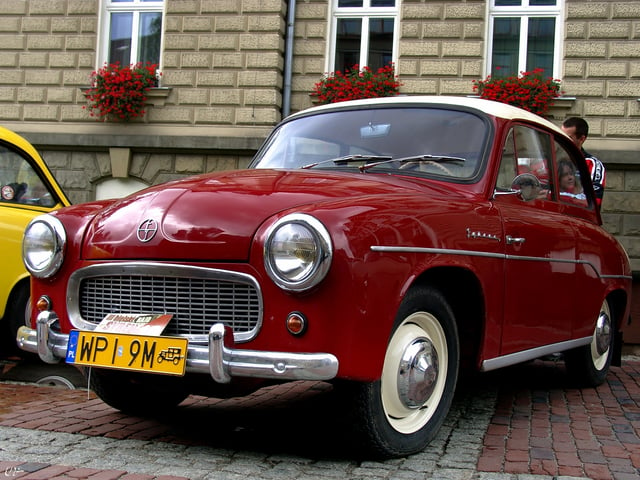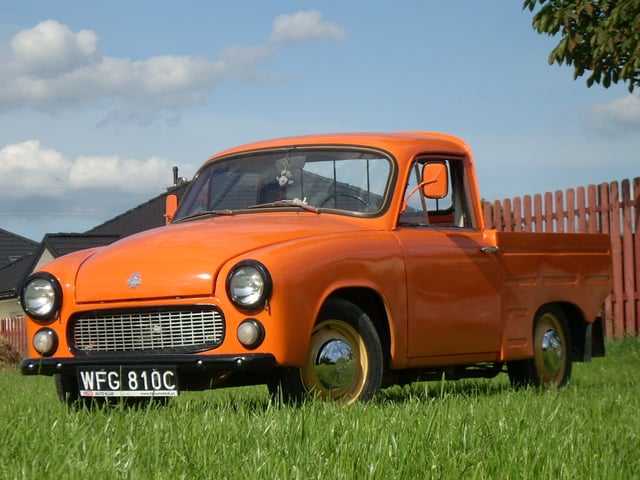FSO Syrena

FSO Syrena

| Syrena | |
|---|---|
| Overview | |
| Manufacturer |
|
| Production | 1957–1983 521,311 produced |
| Body and chassis | |
| Body style |
|
| Layout | FF layout |
| Powertrain | |
| Engine |
|
| Transmission | 4-speed manual |
| Dimensions | |
| Wheelbase | 2,300 mm (91 in) |
| Length | 4,030 mm (159 in) – 4,080 mm (161 in) |
| Width | 1,530 mm (60 in) |
| Height | 1,520 mm (60 in) |
| Curb weight | 950 kg (2,090 lb) |
| Chronology | |
| Successor | Polski Fiat 126p |
The Syrena was a Polish automobile model first exhibited at the Poznań Trade Fair in 1955[1] and manufactured from 1957 to 1972 by the Fabryka Samochodów Osobowych (FSO) in Warsaw and from 1972 to 1983 by Fabryka Samochodów Małolitrażowych (FSM) in Bielsko-Biała. 177,234 were made by FSO and 344,077 by FSM, a total of 521,311. During its remarkably long production run it underwent only minor modifications.
The Syrena was produced in various models: 100, 101, 102, 103, 104, while the most popular model was the 105. All were two-door sedans with two-stroke engines, initially of two cylinders. In 1965 the Syrena received a larger three-cylinder engine.
From 1968 a prototype model named laminat was produced. A van called Syrena Bosto and a pick-up R20 were also produced. A coupé Syrena Sport and a hatchback Syrena 110 (in 1966) remained prototypes only.
A Siren is a mermaid who, according to the legend, protects the river Wisła and the Polish capital city, Warsaw. She is featured on the city's coat of arms. Also a diminutive name Syrenka (little siren) is commonly used for the car in Poland.
| Syrena | |
|---|---|
| Overview | |
| Manufacturer |
|
| Production | 1957–1983 521,311 produced |
| Body and chassis | |
| Body style |
|
| Layout | FF layout |
| Powertrain | |
| Engine |
|
| Transmission | 4-speed manual |
| Dimensions | |
| Wheelbase | 2,300 mm (91 in) |
| Length | 4,030 mm (159 in) – 4,080 mm (161 in) |
| Width | 1,530 mm (60 in) |
| Height | 1,520 mm (60 in) |
| Curb weight | 950 kg (2,090 lb) |
| Chronology | |
| Successor | Polski Fiat 126p |
History
At first, Polish engineers wanted Syrena to have a 4-stroke air-cooled engine and a self-supporting chassis. Due to a lack of deep-drawn metal parts and cost reductions, the first Syrena 100 cars were supposed to have a wooden bodywork covered with leather-like material. The cars were powered by 2-stroke engines designed by engineer Fryderyk Bluemke. The first two preprototypes of Syrena were made in December 1953. One – with a wooden framework, was constructed by Stanislaw Panczakiewicz, while the second, steel-bodied car was made by Stanislaw Lukaszewicz. They met halfway by combining the first car's design with the steel bodywork of the second one (with one exception – the roof remained wooden). By March 1955 FSO had built 5 prototypes of Syrena 100.
In September all of them took part in an experimental rally covering a distance of 5600 km. One of the cars, driven by Karol Pionnier, crashed, revealing the weak structure of the roof. As a result, the engineers decided to use steel instead of wood for this part of the car. One of the prototypes was exhibited at the Poznań Trade Fair in autumn 1955. On 20 March 1957 the mass production of Syrena 100 started.
Syrena 100

Syrena 100
Syrena 100 was designed by engineers Stanislaw Lukasiewicz, Stanislaw Panczakiewicz and Fryderyk Bluemke. It was introduced to the public in June 1955 at the XXIV Poznań Trade Fair. The car aroused a lot of interest, which prompted the government to put it into production. At first, the production rate was to be 10 thousand cars a year. Because of financial reasons, Syrena 100 and the much larger Warszawa automobile shared many parts. As a result, Syrena was much heavier than intended (950 kg).
Syrena 101

Syrena 101
In 1960 Syrena underwent a first, minor modernisation. The improved car had a pneumatic fuel pump and a different type of carburetor. It also received new twin windscreen wipers and a better suspension.
Syrena 102

Syrena 102
The Syrena 102, produced in 1962 and 1963, had slightly different body details. The "S" version of this model shared an engine with Wartburg 312. Around 150 examples of Syrena 102S were produced.
Syrena 103

Syrena 103 - original painting
Syrena 103 (1963–66) had a restyled front and a different engine.
Syrena 104

Syrena 104
The next model lasted from 1966 to 1972. It had a new, three-cylinder engine, a synchronized gearbox and restyled tail lights.
Syrena 105

FSM Syrena 105

1981 FSM Syrena R-20
The 105 was the last Syrena design.[2] It was produced from 1972 to 1983 by the FSM factory and was badged accordingly.[2] Unlike its predecessors it had regular front doors instead of "suicide" ones. The "Lux" version, produced from 1974, had the gear lever and handbrake between the front seats. The 105 served as a basis for two other models – Syrena R-20, which was a pick-up and a van – Bosto.
A 1983 FSM Syrena 105L finished in yellow was featured in series 10 episode 10 of the British television program Wheeler Dealers. Presenter Mike Brewer purchased the car in Poland for zł7,000 (the equivalent of £1,400) and drove it back to the show's UK-based workshop where it underwent repairs and upgrades by mechanic Edd China. The colour was changed to red and white in homage to the Polish flag (coincidentally, also Poland's traditional racing colors). Other work included works to the steering box, refurbishing the drum brakes, replacing the dynamo with an alternator and replacing the radio. The works plus the costs of the car were valued at £5454. The completed car was driven to the Polish embassy where ambassador Witold Sobków took a ride with them. The car was later sold for £8,000 to the bubble car museum in Lincolnshire.
Syrena Sport

Syrena Sport replica
In 1960 a prototype Syrena Sport was produced with a fibreglass body and a four-stroke two-cylinder engine. However the model was not put into production.[2]
See also
List of Eastern European cars